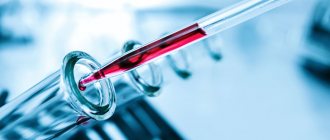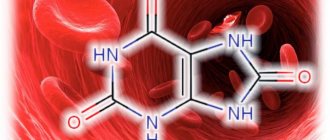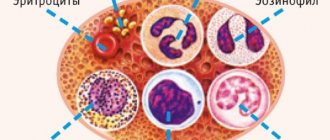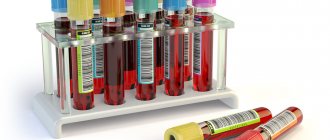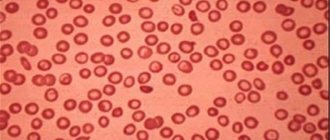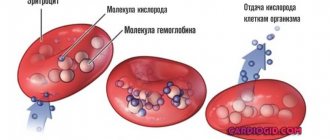The role of red blood cells in the body
Red blood cells are blood cells that perform one of the most important functions in human life - breathing. They deliver oxygen from the lungs to all tissues of the body and remove carbon dioxide.
Red blood cells perform several other important functions:
- Move proteins, carbohydrates, amino acids and other substances between the cells of the body;
- bind and neutralize toxic substances in the blood, cleansing the body;
- participate in the process of blood clotting;
- regulate blood pH levels;
- act as carriers of vitamins B and C, as well as various enzymes.
Consequences of high hemoglobin
Why is a high hemoglobin level dangerous? As a result of oversaturation with red blood cells, the functioning of almost the entire body is disrupted. Thicker blood impairs the functioning of the brain and the process of blood supply to tissues. The size of the internal organs - spleen, liver, kidneys - increases. With such complications, the body does not have time to cope with the negative consequences of saturation with red blood cells. Over time, these symptoms can be fatal, which is why high hemoglobin is life-threatening.
How are red blood cells and hemoglobin related?
Hemoglobin is a complex iron-containing protein. It is found in red blood cells and ensures the delivery of oxygen to the tissues of the body by attaching to itself its molecules obtained from the inhaled air.
Red blood cells act as a kind of conductor of hemoglobin, and it is this protein that directly supplies the body’s tissues with oxygen. In a similar way, hemoglobin absorbs carbon excreted by the body and transports it to the lungs
Symptoms and signs of erythropenia
Erythropenia develops gradually. In mild stages, a person does not feel any changes. With the further development of the pathology, the body no longer has enough hemoglobin and tries to replenish it. To do this, the heart muscle begins to pump blood more often so that the remaining red blood cells deliver oxygen to the tissues faster. A gradual decrease in blood cells is manifested by a number of symptoms:
- dizziness;
- pallor or yellowness of the skin;
- fainting;
- tachycardia;
- drowsiness, constant fatigue;
- inflammation of the oral mucosa or tongue;
- tingling in the limbs;
- the appearance of “flies” before the eyes;
- excessive dry skin, brittle hair and nails;
- noise in ears.
Types of erythropenia
A decrease in the number of red blood cells in the blood below established norms is called erythropenia.
It comes in 2 types:
- Relative. The number of red blood cells decreases in the tested blood due to the entry of a large amount of fluid into the body. This leads to blood thinning. But in the total volume of all blood, the level of red blood cells remains unchanged.
- Absolute – characterized by a low level of red blood cells in the blood. This indicates a violation of the blood formation process.
Symptoms of elevated hemoglobin
The most dangerous thing in cases where hemoglobin is higher than normal occurs inside the vessels: the blood circulates poorly because it becomes thick. If you do not react in time and do not normalize the viscosity of this biological fluid, irreversible consequences will occur. The formation of blood clots and blockage of blood vessels is what increased hemoglobin in the blood means.
The level of iron-containing protein does not rise suddenly, it happens over some time. During this period, the following external symptoms may be observed:
- fatigue, drowsiness;
- loss of appetite, sudden weight loss for no reason;
- increased body temperature;
- red itchy spots on the skin;
- increased blood pressure.
Reasons for decreased blood concentrations in adults and children
Red blood cells in the blood can be low for various reasons.
Red blood cells in the blood are low and normal
The most common of these are the destruction of blood cells as they move through the capillaries and severe bleeding that accompanies large blood loss.
Acute or chronic blood loss
Acute blood loss is characterized by a sharp decrease in blood volume - more than 10%. Most often, bleeding occurs after serious injury, surgery, or a stomach ulcer.
Women can lose a lot of blood during childbirth and during uterine bleeding (spontaneous miscarriage, fetal death, inflammatory processes). Acute blood loss in children most often occurs due to injuries of the brachial, femoral, and iliac arteries.
Chronic blood loss occurs when there is continuous or repeated bleeding.
It occurs more often than acute blood loss. Bleeding may occur when:
- inflammatory processes of the gastrointestinal tract;
- the presence of tumors (in the intestines, bladder, kidneys);
- heavy menstrual flow.
Insufficient production of red blood cells
Red blood cells perform their function for 3-4 months, after which they are replaced by new blood cells produced by the bone marrow. In a second, it produces more than 2 million red blood cells to replenish blood loss in various situations.
Insufficient production of blood cells occurs for 2 main reasons:
- limited dietary intake of microelements (folic acid, iron, copper, vitamin B12) necessary for the production of red blood cells;
- a pathological process in the body that interferes with the normal absorption of substances involved in the formation of blood cells.
Hereditary blood diseases
Some inherited blood diseases can cause low red blood cell levels:
- Hemophilia - a disease accompanied by increased bleeding from minor cuts or injuries due to the fact that the blood clots poorly or does not clot at all - it is very difficult to stop. As a result, a person loses a lot of blood, and the bone marrow does not have time to produce the required number of red blood cells.
- Ovalocytosis is a rare disease in which 40 to 90% of red blood cells are oval. Such blood cells quickly die without fully performing their functions.
- Microspherocytosis is a disease in which red blood cells have a genetic defect in the membrane, as a result of which their life expectancy is reduced.
Enhanced Destruction
The destruction of red blood cells mainly occurs during their circulation through the vessels as a result of mechanical injury. Young blood cells that have just left the bone marrow succumb to such death.
Also leading to resolution:
- decrease in osmotic pressure (osmotic hemolysis);
- enlarged spleen.
Infections
Once in the body, the causative agent of an infectious disease disrupts the functioning of the bone marrow. The organ stops producing the required number of red blood cells, which leads to their reduction.
In children, as in adults, after acute respiratory viral infections and other infectious diseases, analysis may show a reduced level of red blood cells in the blood. This phenomenon is mostly asymptomatic and after the pathogen is destroyed, the level of red blood cells returns to normal.
A decrease in blood cells is also caused by parasites that enter the human blood through mosquito bites. These parasitic organisms feed on red blood cells.
Oncology
A decrease in the level of red blood cells in oncology is associated with various reasons:
- Suppression or complete blocking of bone marrow functions. Malignant tumors that develop in an organ or enter there through metastases stop the production of red blood cells.
- Insufficient intake of iron and other substances involved in the formation of red blood cells due to lack of appetite in patients or caused by the presence of nausea/vomiting.
- Radiation and chemotherapy suppress the process of hematopoiesis.
Autoimmune diseases
When the immune system malfunctions, the body begins to produce antibodies that destroy red blood cells, because they mistakenly perceive them as foreign cells.
The manifestation of an autoimmune reaction occurs in the presence of diseases such as lupus erythematosus, rheumatoid arthritis, cirrhosis of the liver, chronic hepatitis, pyelonephritis (more often in children). The causes of the autoimmune reaction have not yet been established.
Taking certain medications
A decrease in red blood cells can also occur while taking the following medications:
- antibiotics;
- anti-inflammatory nonsteroidal drugs (aspirin, ibuprofen) reduce blood viscosity, increasing the risk of bleeding;
- antacids - drugs designed to neutralize hydrochloric acid in the stomach, which ensures effective absorption of iron;
- medications that bind iron in the body (ferritin, transferrin);
- anti-tumor agents containing platinum - they partially suppress the production of erythropoietin in the kidneys (a hormone that controls the formation of red blood cells).
Pregnancy
A decrease in red blood cells during pregnancy is associated with an increase in fluid in the body. As a result, the blood thins and the hemoglobin level drops. A level below 110 g/l is considered dangerous for a woman, while the norm is 120-140 g/l.
Lack of oxygen supply can lead to a number of complications:
- decreased blood pressure;
- risk of miscarriage;
- delayed fetal development;
- premature birth;
- anemia in a child in the first year of life.
Also, a decrease in red blood cells causes an increased consumption of iron for the blood formation of a pregnant woman and the needs for fetal development.
Varieties
Relative anemia. When overhydration or excess water enters the body, its percentage in the blood increases. The blood flow increases in volume and becomes liquid. There is a decrease in the number of red cells per unit volume of blood, although the total number of RBC cells remains unchanged. Signs of anemia appear. The situation occurs when drinking copious amounts of fluid after drinking alcohol or salty, spicy foods, or when recovering from vomiting. During pregnancy, women accumulate excess water while maintaining the same number of their own RBCs. Relative anemia occurs when blood is retained in the liver, spleen or kidney depots. Anesthesia causes blood to accumulate in individual organs and tissues and increases the water content of the blood.
True anemia. The quality and quantity of bone marrow that produces reticulocytes changes over time and for various reasons. If the changes are minor, then a sufficient number of reticulocytes are produced and the blood functions normally. If the absolute level of new RBCs decreases (or increases) disease occurs. With anemia, the red color of the blood becomes lighter and paler, and with erythrocytosis, it becomes brighter and darker.
True anemia manifests itself in a latent form with dehydration. The reduced level of RBC is compensated by the reserve production of missing cells. External signs of anemia persist, but diagnosis and registration of the disease are difficult.
Symptoms of a lack of red blood cells
Symptoms of a lack of red blood cells are manifested by the following signs:
- general weakness of the body;
- lethargy and drowsiness;
- feeling of constant fatigue;
- pallor of the skin, lips and mucous membranes (symptoms are pronounced in children);
- the appearance of shortness of breath;
- rapid pulse;
- low pressure;
- damp, cold skin
Iron deficiency anemia is when the red blood cells in the blood are low
In a chronic condition, a person experiences slow reactions, lethargy, and fainting. At a critical level of decrease in red blood cells, children may develop muscle atrophy, blood appears in the feces and urine, coordination of movements is impaired, swelling appears, and the color of the urine becomes dark.
Anemia is the cause of low RBC
The most common cause of erythropenia is anemia of various origins:
- iron deficiency;
- B12 is deficient;
- hemolytic;
- hypoplastic.
The condition of anemia can be caused by hereditary factors or acquired during life. With B12 deficiency anemia, red blood cells decrease to 1* 10-12/l.
And if in the blood of an adult the red blood cells are reduced to the specified value or are less than 1* 10-12/l, then this indicates a severe form of anemia and means that it is necessary to immediately eliminate the cause that caused this condition in the patient.
Signs of increased erythropenia, increasing the risk of severe anemia, are the appearance of:
- shortness of breath, feeling of lack of air with little physical exertion;
- floaters before eyes;
- coldness, pallor of the skin, with massive destruction of red blood cells, yellowing of the skin is possible;
- yellowing of the eye sclera;
- dizziness;
- headache;
- weaknesses;
- low blood pressure;
- weak, rapid pulse;
- heartache.
Why is erythropenia dangerous?
Red blood cells in the blood are low - this condition in children can lead to developmental delays, since insufficient oxygen supply to the body's cells and poor removal of carbon dioxide cause disruptions in the functioning of internal organs. Also, the child’s immunity decreases, he begins to get sick often, problems with blood clotting arise, memory and concentration are impaired.
Oxygen starvation is also dangerous for adults, as it causes a number of complications:
- The risk of heart attack, stroke, or heart failure increases because the heart muscle has to contract more often and the heart wears out faster.
- Structural changes in cells, disruption in the functioning of all organs and systems of the body (the liver and kidneys are the first to suffer).
- Brain activity deteriorates - a person may experience confusion and memory impairment.
- Decreased immunity. Once the infection enters the body, the disease begins to develop rapidly and may worsen.
- Women during menstruation may experience weakness, dizziness, and low blood pressure.
Symptoms and signs of erythropenia
Erythropenia develops gradually. In mild stages, a person does not feel any changes. With the further development of the pathology, the body no longer has enough hemoglobin and tries to replenish it. To do this, the heart muscle begins to pump blood more often so that the remaining red blood cells deliver oxygen to the tissues faster. A gradual decrease in blood cells is manifested by a number of symptoms:
- dizziness;
- pallor or yellowness of the skin;
- fainting;
- tachycardia;
- drowsiness, constant fatigue;
- inflammation of the oral mucosa or tongue;
- tingling in the limbs;
- the appearance of “flies” before the eyes;
- excessive dry skin, brittle hair and nails;
- noise in ears.
Normal red blood cell count
The normal level of red blood cells in the blood of people of different ages and different genders is presented in the table below:
| Age | Level (million/1 mm3 blood) |
| Newborn babies (up to 28 days) | 4-6,6 |
| Children from 28 days to 1 year | 3-5,4 |
| One year old children | 3,6-4,9 |
| Children aged 1-14 years | 4,2-4,8 |
| Women | 3,7-5,1 |
| Men | 3,8-5,3 |
| During pregnancy | 3,5-5,6 |
Diagnosis of pathology
Diagnosis of a decrease in the level of red blood cells is based on a laboratory (general) blood test and the symptoms of the sick person.
The presence of erythropenia is indicated by the following changes in the tests:
- Decreased blood color index;
- the number of red blood cells is below normal;
- the presence of red blood cells of different shapes and sizes;
- decreased iron;
- high erythrocyte sedimentation rate (ESR).
If the pediatrician, after receiving blood tests, was unable to detect the cause of the decrease in red blood cells, then a full examination is prescribed. It includes biochemical, immunological tests, ultrasound and CT scans of organs, testing for tumor markers, genetic tests, etc.
Laboratory research
A blood test for red blood cells is carried out as part of the OAC. To have a complete picture of your health, in addition to determining the number of blood cells, the following indicators are calculated:
- hemoglobin;
- ESR—erythrocyte sedimentation rate;
- cellular form;
- erythrocyte index.
When a decrease in red blood cells occurs, a lack of hemoglobin occurs (less than 120 g/l), but it also happens that these 2 parameters are not related to each other. If the ESR increases, this indicates that inflammatory foci are developing in the body. No less important diagnostic value is the shape of the cells, which in the normal state is round with a small depression on both sides. Pathologies are indicated by irregular and different cell shapes.
A decrease in red blood cells in the blood is not always a sign that pathological processes are occurring in the body. Small deviations from the normal limits can be associated with normal physiological processes, for example, changes in diet, excessive physical activity, fatigue. To make a conclusion about the presence of any diseases, it is not enough to identify low red blood cells; you need to analyze the indicators of other biochemical parameters of the blood.
When is the analysis performed?
A general blood test with determination of red blood cells is prescribed if the patient has health complaints and as a preventive measure for the timely detection of diseases that do not have clinical manifestations.
A blood test with red blood cell counting is a basic diagnostic method that shows the slightest changes in the human body. A study is carried out during treatment of the disease to monitor the positive dynamics of the prescribed therapy. If the result shows deviations from the norm, additional examinations are prescribed to make an accurate diagnosis.
Normal values and possible deviations
The number of corpuscles changes in people as they grow older and depending on gender. In infants under 2 weeks of age, the normal level is 3.9-5.9 million/ml. Up to 12 years, their number is 3.3-5.1 million/ml. In an adult body, the concentration of red blood cells decreases slightly. In an adult male, the norm is 4.0-5.0 million/ml; indicators for women are from 3.9 to 4.7. In the body of a pregnant woman, red blood cells are reduced - up to 3 million/ml (this is considered normal).
Important information: How to quickly raise white blood cells at home (what foods increase them)
How is a blood test performed?
A blood test is a comprehensive test that helps doctors determine your overall health. Blood is drawn from a finger or vein in a special room for manipulation on an empty stomach.
One day before the test, a person should not drink alcohol. Also, half an hour before the procedure, smoking, physical activity and stress are prohibited.
Anemia (anemia)
Consultation with a hematologist – 1600 rubles.
Anemia (anemia)
– a group of clinical and hematological syndromes, a characteristic feature of which is a decrease in the concentration of hemoglobin in the blood with a simultaneous decrease in the number of red blood cells.
The diagnosis of anemia is made on the basis of a decrease in the hematocrit level or hemoglobin content in the blood: for men below 42% and 130 g/l, for women - less than 37% and 120 g/l, respectively Source: Bayramalibeyli I.E. Algorithm for diagnosing anemia / I.E. Bayramalibeyli [and others] // Bulletin of the Russian Peoples' Friendship University. Series: Medicine. - 2006. - No. 1 (33). — P. 12-20. .
Moderate anemia is characterized in women by a decrease in hemoglobin content from 119 to 90 g/l, in men - from 129 to 90 g/l. The average degree of anemia, regardless of gender, is characterized by a decrease in hemoglobin from 89 to 80 g/l.
In severe anemia, hemoglobin decreases to less than 60 g/l Source: Sedunova E.G. Structure of incidence of anemia of various origins / E.G. Sedunova, I.R. Baldanova // Bulletin of the Buryat University. - 2010. - No. 12. - S.
151-153. .
Anemia is widespread, affecting approximately a quarter of the population and is often encountered in general medical practice.
The most common form of anemia - iron deficiency - on average in Russia reaches 12% in children from 0 to 15 years old, and in young children - 73%. A high incidence of anemia is also observed in women of childbearing age and in the elderly Source: Poluektova O.Yu.
The most important anemias in general medical practice. Hyporegenerative anemia / O.Yu. Poluektova [and others] // Zemsky doctor. - 2011. - No. 4 (8). — P. 9-13. .
Classification of anemia
Anemia itself is not a disease, but it is a symptom of some diseases. Anemia is divided according to a single classification criterion - a color indicator, which demonstrates the level of saturation of the red blood cell with hemoglobin.
The following anemias are distinguished:
Hypochromic anemia:
- Iron-deficiency anemia;
- Thalassemia.
Normochromic anemia:
- hemolytic anemia;
- posthemorrhagic;
- neoplastic bone marrow diseases;
- aplastic anemia;
- extramarrow tumors;
- anemia due to decreased production of erythropoietin.
Hyperchromic anemia:
- vitamin B12 deficiency anemia;
- folate deficiency anemia;
- myelodysplastic syndrome.
Symptoms of anemia
Shcheglova Raisa Aleksandrovna There are a huge number of types of anemia. They are all treated differently. At SM-Clinic, all patients are carefully examined to determine the causes of this syndrome. This may be a lack of iron, vitamins, intravascular destruction of red blood cells or a violation of their formation in the bone marrow. The most common is iron deficiency anemia, for the treatment of which it is enough to eliminate recurring bleeding and replenish the lack of iron in the body with the help of special medications.
Often, anemia is asymptomatic and is detected only during laboratory diagnostics. In mild form, anemia is manifested by weakness, increased fatigue, general malaise, and decreased concentration.
With more pronounced anemia, even slight physical activity provokes shortness of breath, migraines and tinnitus occur. Severe anemia can cause heart failure. A common symptom of anemia is pallor.
Treatment of anemia
In general, treatment tactics depend on the type of anemia and the severity of the patient’s condition. For example, aplastic anemia is treated with blood transfusions, bone marrow transplantation, and the use of anabolic hormones.
Prevention of anemia
To prevent anemia, it is first necessary to adhere to a balanced, vitamin-rich diet. Because women lose a lot of iron during menstruation, they should pay close attention to their hemoglobin levels.
Popular questions
Can anemia indicate other diseases in the body? Anemia is almost always secondary (with the exception of some congenital diseases). It develops against the background of repeated bleeding, vitamin deficiency, and diseases of the hematopoietic system. Anemia can be caused by intoxication with substances that destroy red blood cells. Can I treat anemia by changing my diet? Yes, if we are talking about anemia caused by vitamin deficiency. But it doesn't happen often. In most cases, a person develops iron deficiency anemia. It cannot be treated with diet because there is not enough iron in foods to replenish its reserves in the body. To cope with anemia, medications are needed. How to prevent the development of anemia? There are two ways to prevent iron deficiency anemia:
- increased consumption of iron-containing foods (red meat, liver);
- preventing blood loss.
That is, you need to either not lose or constantly replenish iron. To do this, it is necessary to promptly identify and treat diseases accompanied by chronic blood loss. If this is not possible, taking iron supplements is indicated. Why is anemia dangerous? At a minimum, anemia is dangerous because it can indicate serious diseases, including cancer. If we talk specifically about the consequences of chronically low hemoglobin levels, they are as follows:
- weakened immunity;
- decreased exercise tolerance and increased risk of heart disease;
- increased risk of purulent-septic processes by 2 times;
- in pregnant women: increased likelihood of spontaneous abortion, intrauterine growth retardation, fetal hypoxia, and labor anomalies.
Identification of signs of anemia in laboratory tests requires mandatory clarification of the causes of the development of this syndrome. Then pathogenetic treatment is carried out aimed at normalizing the level of hemoglobin in the blood.
Sources:
- Bayramalibeyli I.E. Algorithm for diagnosing anemia / I.E. Bayramalibeyli [and others] // Bulletin of the Russian Peoples' Friendship University. Series: Medicine. - 2006. - No. 1 (33). — P. 12-20.
- Poluektova O.Yu. The most important anemias in general medical practice. Hyporegenerative anemia / O.Yu. Poluektova [and others] // Zemsky doctor. - 2011. - No. 4 (8). — P. 9-13.
- Sedunova E.G. Structure of incidence of anemia of various origins / E.G. Sedunova, I.R. Baldanova // Bulletin of the Buryat University. - 2010. - No. 12. - P. 151-153.
How to increase red blood cells?
An integrated approach to treatment will help increase the level of red blood cells in the blood. Taking the necessary medications along with maintaining a healthy lifestyle and adjusting your diet can quickly eliminate this disorder and consolidate the results.
Drug treatment
Red blood cells in the blood can be low for various reasons, so drug treatment is prescribed only after receiving all the data on the pathology. The table below shows medications that help increase the level of blood cells in the body.
| Name | Active substance | Indications for use | How to use? | Contraindications |
| Ferroplex | Ferrous sulfate, vitamin C | Iron deficiency, decreased rate of iron absorption, prolonged bleeding. | For treatment, take 100-200 mg per day, for preventive purposes, take 100 mg. | Children under 12 years of age, aplastic anemia, individual intolerance to components. |
| Cyanocobalamin | Cyanocobalamin (vitamin B12) | Various types of anemia, liver cirrhosis, hepatitis. | For iron deficiency anemia, take 30-100 mcg 2-3 times a day. in Week. Children with aplastic anemia are prescribed 100 mcg per week until performance improves. | Not taken for thromboembolism, angina pectoris. |
| Maltofer Fall | Iron (III) hydroxide, folic acid | Treatment of iron deficiency anemia, prevention of iron deficiency. | To treat anemia, take 1 tablet. 2-3 r. in a day. | Diseases of the digestive system, allergies to the components of the drug, excessive amounts of iron in the body. |
Diet therapy
You can increase your red blood cells by taking iron-containing foods:
- apples (additionally enrich the body with vitamin C);
- beets and freshly squeezed beet juice, diluted with water in a 1:1 ratio.
- buckwheat;
- oatmeal jelly (infused in boiling water);
- meat by-products (beef and pork liver, kidneys, lungs);
- tomatoes;
- dried fruits - prunes, grapes and dried apricots;
- legumes;
- yolks of chicken and quail eggs;
- seafood.
The diet must be balanced and correct. For greater efficiency from consuming healthy foods, you can seek help from a nutritionist - a specialist will tell you how to properly introduce iron-rich products into your daily diet.
Lifestyle
Maintaining a healthy lifestyle will help maintain red blood cell levels within normal limits. Regular exercise, walks in the fresh air, adequate sleep and rest after exercise are recommended. It is worth giving up drinking alcoholic beverages and smoking, since nicotine and alcohol reduce the concentration of red blood cells in the blood and slow down the process of their formation.
Folk remedies
Folk remedies help in the fight against low levels of red blood cells.
The following recipes are popular:
- Rose hip and rowan tea. These fruits contain large amounts of vitamin C, iron and other beneficial components. To prepare the drink, you need to take equal quantities of rowan and rose hips and brew tea from them. It is taken at 1 tbsp. daily.
- Juice from radish, beets and carrots. Take vegetables, grate them, squeeze the juice out of them and add it in equal quantities to a dark glass bowl. It must be covered with a lid (only loosely so that the liquid evaporates), placed in the oven and left to simmer for 3 hours at low temperature. The resulting product is taken 1 tbsp. l. 3 r. per day before meals for 3 months.
- Oat drink. 1 tbsp. oats or cereals pour 5 tbsp. water and cook (the consistency should resemble liquid jelly). Strain the broth, add milk to it (the amount should be the same) and boil again. Add 4 tsp to the resulting mixture. honey and put it on the fire to boil. Take the resulting drink 2-3 times. in a day.
- Alcohol tincture of garlic. Pour 300 g of chopped garlic into 0.5 liters of alcohol and leave in a dark place for 21 days. Use the tincture 3 times. 20 drops per day, after dissolving it in 100 ml of milk.
- Chicory juice with milk. 1 tbsp. l. Stir juice in a glass of milk. Drink the resulting mixture in 3 doses throughout the day.
Prevention
In the old days, anemia was considered an incurable disease. In the modern world, already knowing all the causes and consequences, every fourth inhabitant of the planet suffers from a lack of hemoglobin. Mild stages of the disease do not show signs, so it is necessary to take tests for blood components at least once a year. If you notice any ailments, do not attribute them to weather conditions, but consult a doctor.
Prevention of a decrease in red blood cells is a complete diet and the absence of harmful factors. Foods rich in vitamins and iron should become a frequent guest on the table. Diets, fasting, and unhealthy foods provoke a lack of elements for the generation of red blood cells. Alcohol and tobacco smoke interfere with the absorption of the resulting microelements.
Maintaining immunity at the proper level will help the body cope with the attack of many bacteria and viruses that constantly live around us. Sports, walks in the fresh air, positive emotions and healthy food contribute to the natural flow of all processes in the body, including the work of red blood cells.
Features of treatment of erythropenia in pregnant women
In mild cases of erythropenia, pregnant women are advised to change their diet and add foods containing iron and other microelements. In more severe cases, the gynecologist prescribes a course of treatment based on taking vitamin complexes that contain B vitamins and iron. The table below shows medications approved for use during pregnancy.
| A drug | Main components | dosage |
| Totema | Iron, manganese, copper | 2-4 ampoules per day |
| Ferro-Folgamma | Vitamin B12, ferrous salt, folic acid, vitamin C | 1-2 capsules 3 r. in a day |
| Fenyuls | Ferrous iron, B vitamins, ascorbic acid | 1-2 capsules per day |
| Gyno-tardiferon | Iron, folic acid | 1-3 tables per day (depending on the severity of the disease) |
The course of taking medications intended to normalize the process of hematopoiesis is 1-3 months. If the decrease in red blood cells is associated with impaired kidney function, the treating gynecologist may prescribe diuretics. They will prevent fluid stagnation and normalize blood cell levels.
When the pathology develops against the background of oncology or heart failure, pregnant women are placed in hospital treatment under the constant supervision of medical workers. The treatment regimen is selected individually depending on the disease and its severity.
Causes of low red blood cells.
With blood loss, the number of red blood cells decreases
Blood loss is one of the factors accompanied by a decrease in the level of blood cells. This may be the postoperative period, trauma, as well as bleeding of internal organs (inflammation of hemorrhoids, gastric ulcer with disruption of tissue integrity).
The reason for the decrease in the activity of red blood cells is often a lack of microelements: vitamins B 12, B 9 and iron. This not only reduces the level of blood cells, but also deforms some of the red blood cells remaining in the bloodstream.
Conditions that provoke erythropenia:
- autoimmune diseases,
- liver tissue damage
- parasite infection,
- dysfunction of the thyroid gland,
- intoxication,
- leukemia,
- alcoholism,
- intestinal diseases,
- renal failure,
- bone marrow tumors,
- connective tissue diseases,
- infectious diseases,
- taking anticoagulants,
- genetic pathologies.
Features of treatment for children
The primary task of a pediatrician when treating children is to establish the cause of the decrease in red blood cells. If the development of pathology is associated with a violation of the production of blood cells in the bone marrow, drugs are prescribed that stimulate the process of hematopoiesis. Bleeding that causes acute blood loss requires surgical treatment and blood transfusion.
If the decrease in red blood cells is caused by a lack of iron in the body, the pediatrician prescribes special iron-containing drugs.
Among the large number of drugs, the most popular and effective drugs are:
- Maltofer. Drops have no age restrictions. The daily dosage is 1-2 drops per 1 kg of child’s weight. Before use, the drug is mixed with water, juice or compote.
- Ferrum-Lek. The syrup is intended for children over one year of age. 1 scoop contains 50 mg of active iron. When treating children aged 1-12 years, the daily dose is 5-10 ml. When taking the drug for prophylaxis, the dosage is 2.5-5 ml.
- Aktiferin. Drops are taken before or during meals. They should be diluted with a small amount of water or juice. The daily dose for children under one year is 10-15 drops 3 r. in a day. Children aged 1-2 years are given 15-25 drops of the drug three times a day. The daily dosage for children aged 2 to 6 years is 25-35 drops. For children over 6 years of age, it is advisable to take the drug in capsule form.
Lifestyle
Making simple lifestyle changes can have a significant impact on your red blood cell count.
Reducing alcohol consumption
It may be helpful to eliminate or reduce alcoholic beverages from your diet, as drinking too much alcohol can lower your red blood cell count.
Dietary guidelines recommend moderate alcohol consumption for adult men as two alcoholic drinks per day or less. For adult women, moderate drinking is one alcoholic drink per day or less.
Physical exercise
Moderate exercise can provide benefits to any person who practices it. However, it is especially important for creating healthy red blood cells.
Long-term vigorous exercise that increases your heart rate increases the body and brain's need for oxygen. This is why the heart beats faster and the lungs breathe deeper and faster.
This need for oxygen stimulates the body to produce more red blood cells. Regular exercise along with a healthy diet means that the bone marrow has the best tools to create these cells.
Possible workouts include:
- jogging
- a ride on the bicycle
- swimming
- guided exercise classes such as aerobics
However, even using the stairs instead of the elevator, going for a walk or gardening, you can expect a daily or weekly need for exercise.
Possible complications
Red blood cells are low most often due to iron deficiency anemia. According to statistics, every 4th resident of the country has this disease. Its early stage (when fatigue and slight malaise are felt) quickly develops into a more severe form - a person experiences memory loss, disorientation, convulsions and constant muscle pain.
Complications, if the pathology is not treated, can include partial or complete paralysis, memory loss, complete muscle atrophy and even death.
A decrease in the level of red blood cells in the blood can be caused by various reasons. Timely diagnosis and implementation of the attending physician’s recommendations will help eliminate this pathology with minimal damage to health.
Signs of decline
In order to determine changes in the corpuscle ratio, it is necessary to periodically conduct laboratory tests. The patient may not have too obvious signs.
However, it is worth knowing that after certain incidents, for example, with anemia or too much blood loss, it is necessary to conduct research.
In order to decide that it is time to get tested, you should pay attention to the following symptoms.
- The patient constantly feels general weakness. Moreover, in some cases, such a situation can be interpreted by him as a consequence of overwork, etc.
- Often, with a low level of leukocytes, low-grade fever occurs.
- The patient experiences an excessive occurrence of various diseases. For example, infectious or colds.
In the event that a patient consults a doctor with similar symptoms and a general examination demonstrates a reduced index of these cells.
A broader and more extensive study is needed. It will allow you to determine not only the presence of a reduced amount, but also the reasons.
